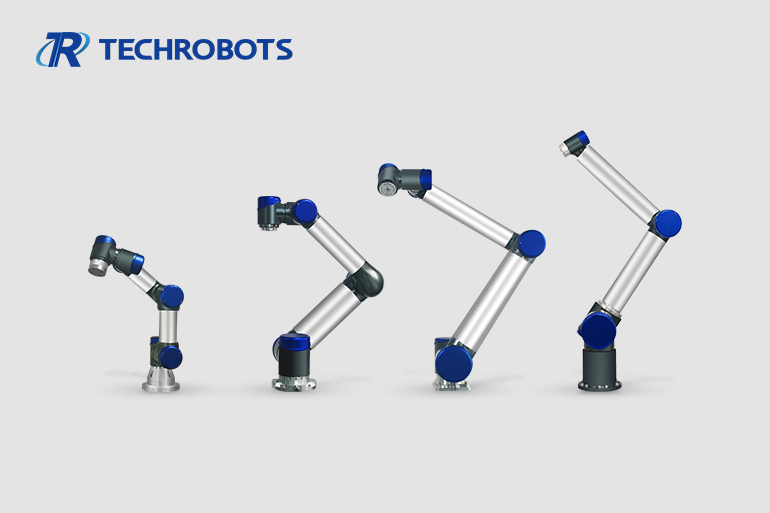Why are co-robots more suitable for smart factories?
Date:2020-07-08
As a new type of robot that attracts attention, co-robots have the advantages of collaborative safety, simple deployment, low cost, easy operation, and easy to use.
First, co-robots inherit the advantages of traditional industrial robots and are equipped with visual and tactile sensors. Compared with the former, co-robots have a more intelligent software operating system. This ensures that they can work in a more flexible environment, meaning that they know their relationship with their surroundings and can adjust to changes in the environment. Their safety is completely different from traditional robots.
Secondly, the industrial robots used in mainstream situations have prices ranging from 200,000 yuan to 400,000 yuan according to different carrying capacities, but their high deployment costs will block most small and medium-sized enterprises. However, co-robots are much cheaper. For example, China’s Techrobots sells for less than 100,000 yuan, the American Sawyer costs $29,000, and the Danish Universal UR10 costs $35,000. Also, it can save a lot. Cost of deployment.

Finally, the co-robot is independent. It can replace individuals. The two can be interchanged. If a co-robot fails, as long as a person is found to replace it, it can ensure the normal work of the entire production process. Just like Techrobots, they only need to set up programs to control their "arms". After completing the settings, they can work with humans to perform various repetitive tasks on the production line.
According to research data, by 2021, sales of co-robots will reach 150,000 units, and sales are expected to increase to 2 billion US dollars. According to a report released last year, by the end of 2024, the global market capitalization of co-robots will reach 95 billion US dollars, with a compound annual growth rate of 30%. The deployment of co-robots has become a priority for smart factories.
As one of the manufacturers of co-robots, Shenzhen TTechrobotst developed the first series of RJS series robot joint modules in 2016, and then launched the first co-robot TA6 series, setting the target market for 3C, automotive assembly And research and education industry. With the emergence of the TA6 series of co-robots, Techrobots has transformed from the previously produced servo motion control products and formally entered the emerging collaborative robot market. In the subsequent research and development process, Techrobots continuously launched RJSII series robot joint modules, RJU series robot joint modules and SHD robot actuators, and independently developed multiple series of co-robots TB6 series and simple co-robot series.

First, co-robots inherit the advantages of traditional industrial robots and are equipped with visual and tactile sensors. Compared with the former, co-robots have a more intelligent software operating system. This ensures that they can work in a more flexible environment, meaning that they know their relationship with their surroundings and can adjust to changes in the environment. Their safety is completely different from traditional robots.
Secondly, the industrial robots used in mainstream situations have prices ranging from 200,000 yuan to 400,000 yuan according to different carrying capacities, but their high deployment costs will block most small and medium-sized enterprises. However, co-robots are much cheaper. For example, China’s Techrobots sells for less than 100,000 yuan, the American Sawyer costs $29,000, and the Danish Universal UR10 costs $35,000. Also, it can save a lot. Cost of deployment.

Finally, the co-robot is independent. It can replace individuals. The two can be interchanged. If a co-robot fails, as long as a person is found to replace it, it can ensure the normal work of the entire production process. Just like Techrobots, they only need to set up programs to control their "arms". After completing the settings, they can work with humans to perform various repetitive tasks on the production line.
According to research data, by 2021, sales of co-robots will reach 150,000 units, and sales are expected to increase to 2 billion US dollars. According to a report released last year, by the end of 2024, the global market capitalization of co-robots will reach 95 billion US dollars, with a compound annual growth rate of 30%. The deployment of co-robots has become a priority for smart factories.
As one of the manufacturers of co-robots, Shenzhen TTechrobotst developed the first series of RJS series robot joint modules in 2016, and then launched the first co-robot TA6 series, setting the target market for 3C, automotive assembly And research and education industry. With the emergence of the TA6 series of co-robots, Techrobots has transformed from the previously produced servo motion control products and formally entered the emerging collaborative robot market. In the subsequent research and development process, Techrobots continuously launched RJSII series robot joint modules, RJU series robot joint modules and SHD robot actuators, and independently developed multiple series of co-robots TB6 series and simple co-robot series.

Previous Article: The development status and problems of robot market
Next Article: The robot industry in Shenzhen shows